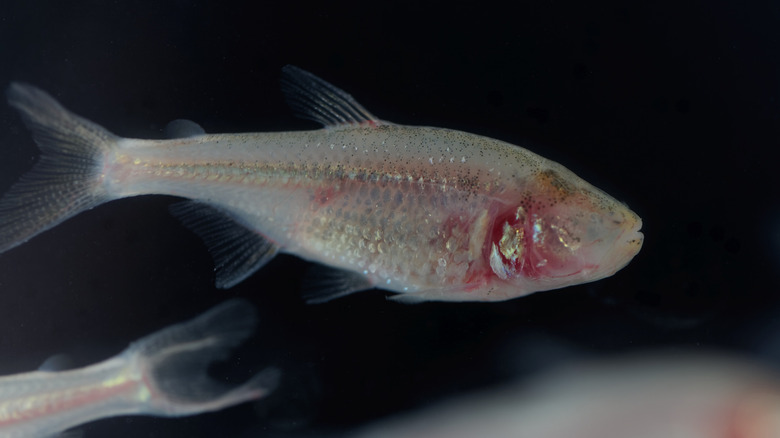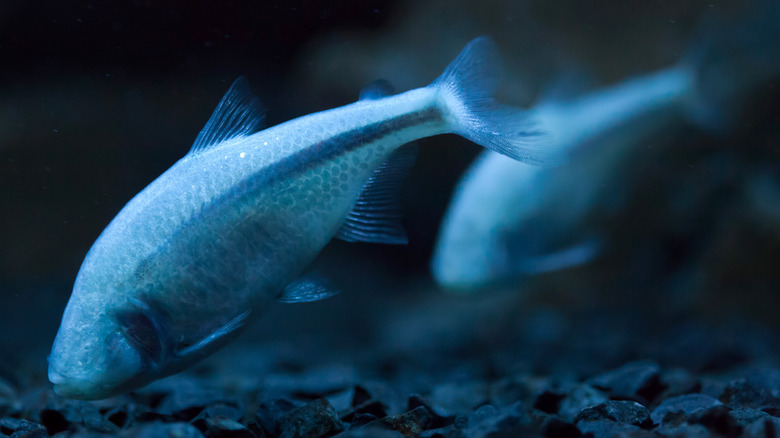How Cavefish Could Give Clues Into The Next Steps Of Human Evolution
With the advent of the smartphone among other technological amenities, not to mention the desk-bound office work that many of us engage in on a daily basis, health experts worry that humans have grown too sedentary in our lifestyles which has led to a whole host of preventable health problems. Could our modern way of life, though, as everything from movie streaming to grocery delivery services, not to mention the COVID-19 pandemic social gathering and travel restrictions, keeps us in our homes more than ever before, lead to evolutionary changes in humans as a species?
University of Cincinnati researchers studied a Mexican species of fish, the cavefish or blind cave tetra, that through no fault of its own, had a significant number of its own species trapped in deep, dark, cold caves with little food and no sunlight some 160,000 years ago, while other members of the same species lived aboveground, according to the University of Cincinnati (UC) News. Their findings, now published in the Proceedings of the National Academies of Science (PNAS), offer some insight into what humans of the future might look like after many generations have passed if the modern world's slow-moving way of life goes on unabated.
Cavefish make for perfect test subjects
As The Washington Post notes, Mexican cavefish have long been the subject of scientific inquiry for the genetic underpinnings of albinism, obesity, and blindness, among other areas of interest. In contrast to their non-cave-trapped relatives, cavefish have lost their eyesight and typical coloration after tens of thousands of years of living in the dark. To reach their most recent conclusions on the evolutionary effects of an inactive lifestyle, researchers observed in the lab both wild and farmed members of surface fish and their cave cousins. This contrast of two closely related though evolutionarily different creatures of the same species also made cavefish prime test subjects for the long-term effects of a slow-moving lifestyle.
Changes observed in cavefish are due to the fact that they have no predators in their darkened remote environment, but neither do they have a particularly abundant source of food. The underground bodies of water cavefish live in also have no real current to swim with or against. Associate professor of biology at the University of Cincinnati Joshua Gross, who was not involved in the PNAS study, told The Post, " ... [I]n humans, it has been long understood that a sedentary lifestyle leads to pretty negative health outcomes, but those come within a lifetime." The cavefish study, Gross said, "provides an idea of how inactivity can play out not just in a lifetime," but through long-term evolutionary change.
Use it or lose it
As The Post points out, parallels can be drawn between humans and cavefish: both creatures are vertebrates, and we are otherwise genetically similar to this tiny swimmers. Moreover, in their cave environments, cavefish have lost most of their reasons to move quickly, just like human beings. There are no predators to get away from, just like us, and though scarce, the little food that they have available to them is easy to come by, with no need to chase it down — think of that next time you order lunch via GrubHub. Add to that, zero current in the still underground bodies of water, and over time, cavefish have undergone significant changes to their musculature, the UC research found.
According to researchers, wild-born cavefish have developed smaller muscle fibers when compared to their surface-dwelling counterparts and lab-born relatives. According to the study, this was due to the inactive way of life of natural-bred cavefish, whereas lab cavefish had access to an abundant food source in the lab, which caused them to grow larger, reflecting the fact their systems metabolized what they ate less quickly than their below-ground corollaries. Muscle fibers, typically used for movement, had become a fat and nutrient storage site which helped the fish survive long periods with little to eat. What that means for us — many, many generations down the road — humans may grow smaller and even more prone to obesity.


